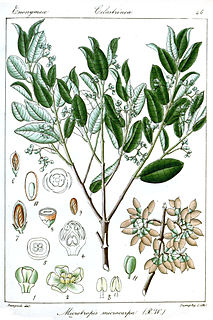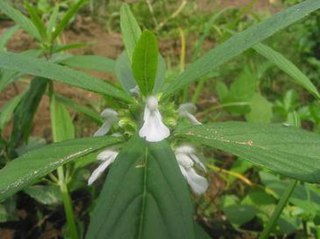
Mangifera is a genus of flowering plants in the cashew family, Anacardiaceae. It contains approximately 69 species, with the best-known being the Common Mango. The center of diversity is in subtropical and tropical South Asia and Southeast Asia, while the highest number of species occur in India. They are generally canopy trees in lowland rainforests, reaching a height of 30–40 m (98–131 ft).

Sarcococca is a genus of 11 species of flowering plants in the box family Buxaceae, native to eastern and southeastern Asia and the Himalayas. They are slow-growing, monoecious, evergreen shrubs 1–2 m (3–7 ft) tall. The leaves are borne alternately, 3–12 cm long and 1–4 cm broad.

Crudia zeylanica, sometimes known as Sri Lanka legume, is a species of plant in the family Fabaceae endemic to Sri Lanka. Once thought to be extinct, the plant was rediscovered in 2019 by three young research scientists including Himesh Dilruwan Jayasinghe.

Capparis is a flowering plant genus in the family Capparaceae which is included in the Brassicaceae in the unrevised APG II system. These plants are shrubs or lianas and are collectively known as caper shrubs or caperbushes. Capparis species occur over a wide range of habitat in the subtropical and tropical zones.

Mangifera zeylanica or “Sri Lanka wild mango” is a wild species of mango tree endemic to Sri Lanka. This stately tree is the tallest member of the mango genus, Mangifera, and one of the two tallest trees in the family Anacardiaceae. The mango fruits are edible and have an excellent taste. It is called "aetamba" (ඇටඹ) or "wal amba" in Sinhala and “kaddu-ma” in Tamil. The well-known British botanist and explorer Joseph Dalton Hooker first described the tree in 1876.

Microtropis is a genus of plant in family Celastraceae. There are about 70 species. They are trees and shrubs, evergreen or deciduous, with oppositely arranged leaves and white or yellowish flowers. Microtropis are distributed in Asia, Africa, and Central America.
Microtropis borneensis is a species of plant in the family Celastraceae. It is endemic to Borneo.
Microtropis densiflora is a species of plant in the family Celastraceae. It is endemic to Tamil Nadu in India.
Microtropis keningauensis is a species of plant in the family Celastraceae. It is endemic to Borneo where it is confined to Sabah.
Microtropis sarawakensis is a species of plant in the family Celastraceae. It is a tree endemic to Borneo where it is confined to Sarawak.

Olax is a plant genus in the family Olacaceae. The name derives from the Latin, olax (malodorous), and refers to the unpleasant scent of some of the Olax species.

Sphenoclea is a genus of succulent erect annual herbs. They occur in damp habitats throughout the tropics.

Plumbago zeylanica, commonly known as Ceylon leadwort, doctorbush or wild leadwort, is a species of plumbago with a pantropical distribution. Carl Linnaeus described the paleotropical P. zeylanica and Neotropical P. scandens as separate species, but they are currently considered synonymous.

Leucas zeylanica, commonly known as Ceylon slitwort, is a small, terrestrial, herbaceous, annual, erect or sometimes tufted, hispid and aromatic plant of the subfamily Lamioideae of family Lamiaceae. It is native to Tropical Asia and Malaya. Botanical synonyms include Leucas bancana Miq., Phlomis zeylanica Linn., and Spermacoce denticulata Walp. It is also known as ගැටතුඹ (geta-tumba) in Sinhala, halkusha in Bengali, guldora in Punjabi, kulnnphul in Gujarati, goma madhupati in Hindi, kubo in Sindhi, bhutamari in Oriya, bahuphul in Marathi, thumbai in Tamil, thumbe in Kannada, thummi in Telugu, and thumba in Malayalam.
Hunteria zeylanica grows as either an evergreen shrub or as a tree up to 15 metres (49 ft) tall, with a trunk diameter of up to 34.5 centimetres (13.6 in). Its flowers feature a white corolla. The berries are yellow. Its habitat is forests from sea level to 350 metres (1,150 ft) altitude. The trees can withstand salinity. Local medicinal uses include for stomach-ache. Hunteria zeylanica wood is used for weapon handles and as firewood. In Africa, the plant is native to Kenya and Tanzania and in Asia it is native to China, India, Sri Lanka, Indochina and western Malesia.
Sarcococca zeylanica is a species of evergreen shrub or groundcover, endemic to Sri Lanka.
Olax zeylanica is a plant species in the family Olacaceae and the type species of the genus Olax. It is found in Bangladesh, India, Myanmar, Sri Lanka, where it is widely used as a leafy vegetable in rural areas. It is known by local people as "මැල්ල - mella" in Sri Lanka.
Microtropis wallichiana is a species of small tree in the family Celastraceae. It is native to India and Sri Lanka. Its leaves are simple, opposite, decussate, and estipulate. The tree is about 15m high. Branchlets are yellowish in mature trees and darker in the youngest. The fruit is a capsule, 1-seeded; flowers are bisexual with 5 petals. Flowering and fruiting occur in December and January.

Sphenoclea zeylanica, called chickenspike, gooseweed, and wedgewort, is a widespread species of flowering plant in the genus Sphenoclea, native to Africa, Madagascar, tropical and subtropical Asia, and Australia. It is widely introduced in the New World tropics and subtopics from the southern United States to northern Argentina. Its young leaves are edible and are occasionally eaten, perhaps with a light boiling. A common weed of rice paddies, it can cause yield losses from 25 to 50%.










